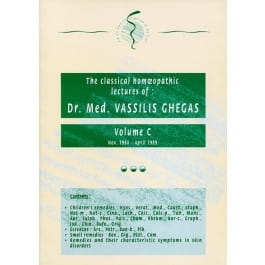Classical Homeopathic Lectures: Volume C
Preface to Volume C
Volume C contains 'Materia Medica' information of 2 successive seminars.
A part of the information of the seminar November 1988 in Bloemendaal (NL) can be found in Volume B. The rest of the information, i.e. a number of children's remedies, can be found in this Volume.
In the seminar of April 1989 in Bloemendaal, Vassilis discussed the other children's remedies and all the other information which you will read in this book.
In all, 25 children's remedies are brought together in this book. Not that these remedies are only seen in children, but Vassilis Ghegas mainly discusses the symptoms which are particularly seen in children and especially the way these symptoms are to be recognized in daily homeopathic practice.
In his seminars, he gives more information about children, mainly during discussions of essences, by giving an additional description of how to recognize the remedy discussed in children.
In this Volume, he continues with remedies and their characteristic symptoms in skin disorders, which is partially discussed in Volume A page A. 134.
I want to point out that in the course of the 2 seminars mentioned above, Vassilis Ghegas spent a lot of time on the discussion ' How to take the case, how to handle the patient': the first consultation, the first prescription, possible reactions to a homoeopathic remedy, the second consultation, the second prescription, all aspects of follow-up, potencies etc. Because this information forms a whole in itself, it will be put together in the next book, Volume D.
From the Publisher:
When Vassilis Ghegas gave his first lecture at a conference of the "Society of Homeopaths" in England in September 1983, none could have expected that this would be the start of a brilliant, didactic series of lessons which are still continued today.
Vassilis is a master in hierarchical teaching. He discusses all topics that occur in homeopathic practice, but the information he provides is hierarchically structured - not alphabetically. He first gives the information that you will frequently need in practice, and later on, he presents less frequent topics and situations. So, he guides his students through a kind of structured evolution process he has been through himself.
Vassilis uses a central idea when presenting the essence of polychrests. This central idea is found on mental, emotional and physical levels, so that it is of great help in the differential diagnosis (e.g.: ARS.: "tendency to self-preservation"; LACH.: "overstimulation which seeks an outlet"; NUX-V.: "efforts beyond the abilities"; PLAT.: "excessive needs, who seeks for balance" etc.)
This series of books chronologically follows Vassilis' seminars, so that the keen reader can take advantage of this evolution. For that reason, this series is the best written course in Classical Homeopathy. Beginning student homeopaths can - via this series - practically learn how to use Kent's Repertory and Boericke's Materia Medica and also understand the practical application of The Organon and The Chronic Diseases by Hahnemann. Experienced homeopaths can test the established information of this series by their own practice.
George Vithoulkas:
"... As far as I have seen, Vassilis has given a correct presentation of what I have taught him over the years. I think he has produced a very well done and informative series of books which will be of great help to the homeopathic community ..."
George Vithoulkas' comment proves that Vassilis Ghegas has continued the work he started under his supervision at the Athenian School for Homeopathy.
- Author: Vassilis Ghegas
- ISBN: 9789074077187
- 206 pages
- Paperback
- Published in 2010
- Printed in Belgium

